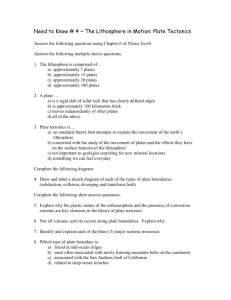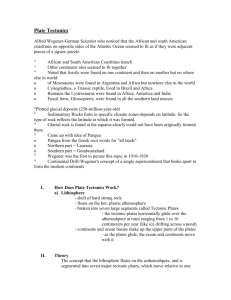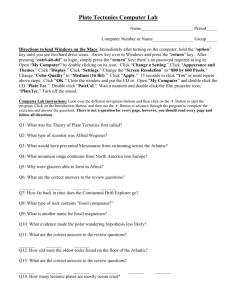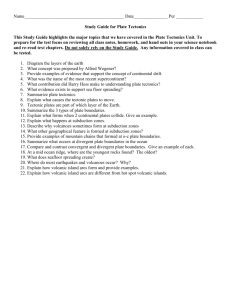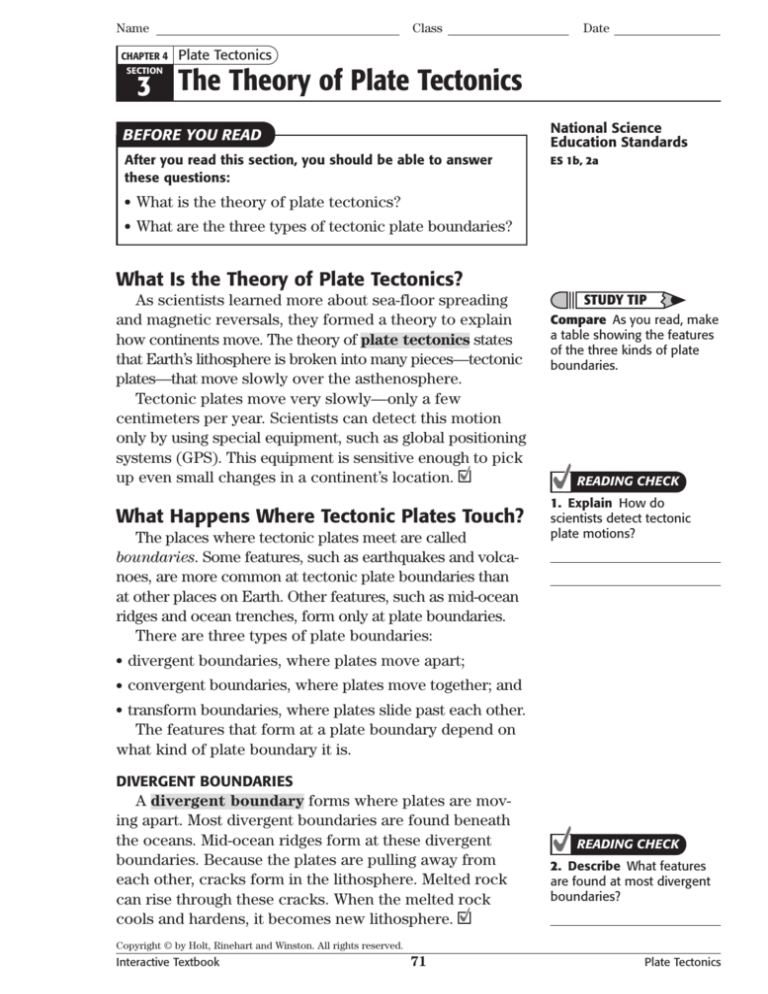
Name
CHAPTER 4
Class
Date
Plate Tectonics
3 The Theory of Plate Tectonics
SECTION
National Science
Education Standards
BEFORE YOU READ
After you read this section, you should be able to answer
these questions:
ES 1b, 2a
• What is the theory of plate tectonics?
• What are the three types of tectonic plate boundaries?
What Is the Theory of Plate Tectonics?
As scientists learned more about sea-floor spreading
and magnetic reversals, they formed a theory to explain
how continents move. The theory of plate tectonics states
that Earth’s lithosphere is broken into many pieces—tectonic
plates—that move slowly over the asthenosphere.
Tectonic plates move very slowly—only a few
centimeters per year. Scientists can detect this motion
only by using special equipment, such as global positioning
systems (GPS). This equipment is sensitive enough to pick
up even small changes in a continent’s location.
What Happens Where Tectonic Plates Touch?
The places where tectonic plates meet are called
boundaries. Some features, such as earthquakes and volcanoes, are more common at tectonic plate boundaries than
at other places on Earth. Other features, such as mid-ocean
ridges and ocean trenches, form only at plate boundaries.
There are three types of plate boundaries:
STUDY TIP
Compare As you read, make
a table showing the features
of the three kinds of plate
boundaries.
READING CHECK
1. Explain How do
scientists detect tectonic
plate motions?
• divergent boundaries, where plates move apart;
• convergent boundaries, where plates move together; and
• transform boundaries, where plates slide past each other.
The features that form at a plate boundary depend on
what kind of plate boundary it is.
DIVERGENT BOUNDARIES
A divergent boundary forms where plates are moving apart. Most divergent boundaries are found beneath
the oceans. Mid-ocean ridges form at these divergent
boundaries. Because the plates are pulling away from
each other, cracks form in the lithosphere. Melted rock
can rise through these cracks. When the melted rock
cools and hardens, it becomes new lithosphere.
READING CHECK
2. Describe What features
are found at most divergent
boundaries?
Copyright © by Holt, Rinehart and Winston. All rights reserved.
Interactive Textbook
71
Plate Tectonics
Name
SECTION 3
Class
Date
The Theory of Plate Tectonics continued
CONVERGENT BOUNDARIES
Critical Thinking
3. Infer Why do continentcontinent convergent
boundaries produce very tall
mountain ranges?
A convergent boundary forms where plates are moving together. There are three different types of convergent boundaries:
• Continent-Continent Boundaries These form when
continental lithosphere on one plate collides with continental lithosphere on another plate. Continent-continent
convergent boundaries can produce very tall mountain
ranges, such as the Himalayas.
• Continent-Ocean Boundaries These form when continental lithosphere on one plate collides with oceanic
lithosphere on another plate. The denser oceanic lithosphere sinks underneath the continental lithosphere in
a process called subduction. Subduction can cause a
chain of mountains, such as the Andes, to form along
the plate boundary.
• Ocean-Ocean Boundaries These form when oceanic
STANDARDS CHECK
ES 1b Lithospheric plates on the
scales of continents and oceans
constantly move in response
to movements in the mantle.
Major geological events, such as
earthquakes, volcanic eruptions,
and mountain building result from
these plate motions.
Word Help: response
an action brought on by
another action; a reaction
Word Help: major
of great importance or
large scale
4. Identify Name two
structures that can form
at convergent plate
boundaries.
lithosphere on one plate collides with oceanic lithosphere on another plate. One of the plates subducts
beneath the other. A series of volcanic islands, called an
island arc, can form along the plate boundary.
�������������������������������
�������������������������������
���������������������������������
�������������������������������
���������������
��������������������������������
����������������������������������
������������������������������������
��������������������������������
�����������������������������������
��������������������������
������������
�����������
����������������
����������������������������
����������������������
��������������������������������
���������������������������
�������������������������������
�������������������������
TRANSFORM BOUNDARIES
A transform boundary forms where plates slide past
each other horizontally. Most transform boundaries are
found near mid-ocean ridges. The ridges are broken into
segments, or pieces. Transform boundaries separate the
segments from one another.
�����������������
One
well-known transform boundary is the San
��������
�������
Andreas
fault system in California. It is located where the
�������
Pacific and North American plates slide past each other.
Copyright © by Holt, Rinehart and Winston. All rights reserved.
Interactive Textbook
72
Plate Tectonics
Name
Class
SECTION 3
Date
The Theory of Plate Tectonics continued
Why Do Tectonic Plates Move?
Scientists do not know for sure what causes tectonic
plates to move. They have three main hypotheses to explain
plate movements: convection, slab pull, and ridge push.
Scientists used to think that convection in the mantle
was the main force that caused plate motions. Remember
that convection happens when matter carries heat from
one place to another. Convection happens in the mantle
as rock heats up and expands. As it expands, it becomes
less dense and rises toward Earth’s surface.
As the hot material rises, cold, dense lithosphere
sinks into the mantle at subduction zones. The rising hot
material and the sinking cold material form convection
currents. Until the 1990s, many scientists thought that
these convection currents pulled the tectonic plates over
Earth’s surface.
Today, most scientists think that slab pull is the main
force that causes plate motions. During subduction, oceanic lithosphere at the edge of a plate sinks into the mantle. The oceanic lithosphere sinks because it is colder and
denser than the mantle. As the lithosphere at the edge of
the plate sinks, it pulls the rest of the plate along with it.
This process is called slab pull.
Another possible cause of plate motions is ridge push.
At mid-ocean ridges, new oceanic lithosphere forms. This
new lithosphere is warmer and less dense than the older
lithosphere farther from the ridge. Therefore, it floats
higher on the asthenosphere than the older lithosphere.
As gravity pulls the new lithosphere down, the plate
slides away from the mid-ocean ridge. This process is
called ridge push.
Driving Force
Description
Slab pull
Cold, sinking lithosphere at the edges of
a tectonic plate pulls the rest of the plate
across Earth’s surface.
Ridge push
Gravity pulls newly formed lithosphere
downward and away from the mid-ocean
ridge. The rest of the plate moves because
of this force.
Convection
currents
Convection currents are produced when
hot material in the mantle rises toward
the surface and colder material sinks. The
currents pull the plates over Earth’s surface.
READING CHECK
5. Define What is convection?
Critical Thinking
6. Compare How is slab pull
different from ridge push?
Copyright © by Holt, Rinehart and Winston. All rights reserved.
Interactive Textbook
73
Plate Tectonics
Name
Class
Date
Section 3 Review
NSES
ES 1b, 2a
SECTION VOCABULARY
convergent boundary the boundary between
tectonic plates that are colliding
divergent boundary the boundary between
two tectonic plates that are moving away from
each other
plate tectonics the theory that explains how
large pieces of the Earth’s outermost layer,
called tectonic plates, move and change shape
transform boundary the boundary between
tectonic plates that are sliding past each other
horizontally
1. Define Write your own definition for plate tectonics.
2. Identify What are the three types of plate boundaries?
3. List Name three processes that may cause tectonic plates to move.
4. Describe How fast do tectonic plates move?
5. Identify Give two features that are found only at plate boundaries, and two fea-
tures that are found most commonly at plate boundaries.
6. Explain Why does oceanic lithosphere sink beneath continental lithosphere at
convergent boundaries?
Copyright © by Holt, Rinehart and Winston. All rights reserved.
Interactive Textbook
74
Plate Tectonics
F
Inside the Restless Earth Answer Key continued
SECTION 4 DEFORMING THE EARTH’S
CRUST
2. Magma rises toward the surface at mid-ocean
ridges. As the tectonic plates move away from
each other, the sea floor spreads apart, and
magma fills the gap. Then the magma solidifies.
3. younger
4. When oceanic lithosphere forms, magnetic minerals in the magma align with Earth’s magnetic
field. They are frozen in place when the magma
cools and hardens. As sea-floor spreading
continues, that part of the lithosphere moves
away from the ridge. If Earth’s magnetic field
reverses, then minerals will align in the opposite direction in the new lithosphere forming
at the ridge. Since lithosphere is produced on
both sides of the ridge, the normal and reversed
magnetic stripes form parallel patterns.
5. The Earth is not getting bigger, new sea
floor is being created, and the oldest sea
floor is only 180 million years old. If those
three things are true, then oceanic crust
must be being destroyed somewhere on
Earth at the same rate that it is being produced.
1. The image on the right should be circled.
2. the amount of force per unit area on an object
3. Most rock layers are horizontal when they
4.
5.
6.
7.
8.
9.
10.
SECTION 3 THE THEORY OF PLATE
TECTONICS
11.
12.
13.
1. using GPS equipment
2. mid-ocean ridges
3. The lithosphere on each plate is very thick.
When the plates collide, the lithosphere is
piled up to form tall mountains.
4. mountains, volcanoes
5. when matter carries heat from place to
place
6. In slab pull, the driving force comes from subducting slabs. In ridge push, the driving force
comes from the formation of new sea floor.
6.
Type of mountain
Description
Folded
formed at convergent
boundaries; made of folded
and crumpled rock
Fault-block
formed where the crust is under
tension; made of faulted rock
Volcanic
formed where volcanoes erupt
above Earth’s surface; made of
igneous rock
14. As it cools, it becomes denser and sinks.
15. the weight of the glacier
Review
1. a theory that describes how tectonic plates
2.
3.
4.
5.
form. They can show folded shapes only if
they have been deformed.
The oldest rock layers should be blue, and
the youngest should be red.
The hanging wall is found above the fault.
A lot of tension is produced at divergent
boundaries.
The wall above the fault plane should be
labeled “hanging wall”; the wall below the
fault plane should be labeled “footwall.”
when fault blocks slide past each other
horizontally
The hanging wall has moved down relative
to the footwall.
Most mountains are the result of plate
movements. Since plates move very slowly,
mountains form very slowly.
tension
continent-ocean
Review
1. Folding and faulting are both responses to
move and change shape as part of Earth’s
outermost layer
convergent, divergent, transform
slab pull, ridge push, convection
a few centimeters per year
Mid-ocean ridges and ocean trenches are
found only at plate boundaries. Earthquakes
and volcanoes are found mainly at plate
boundaries.
Oceanic lithosphere is colder and denser
than continental lithosphere.
stress. During folding, rocks bend under stress.
During faulting, rocks break under stress.
2.
Kind of fault
Description
Kind of stress
that produces it
Normal
Hanging wall
moves down;
footwall moves
up.
tension
Reverse
Hanging wall
moves up;
footwall moves
down.
compression
Strike-slip
Fault blocks
move past
each other
horizontally.
shear stress
Copyright © by Holt, Rinehart and Winston. All rights reserved.
Interactive Textbook Answer Key
40
Inside the Restless Earth

